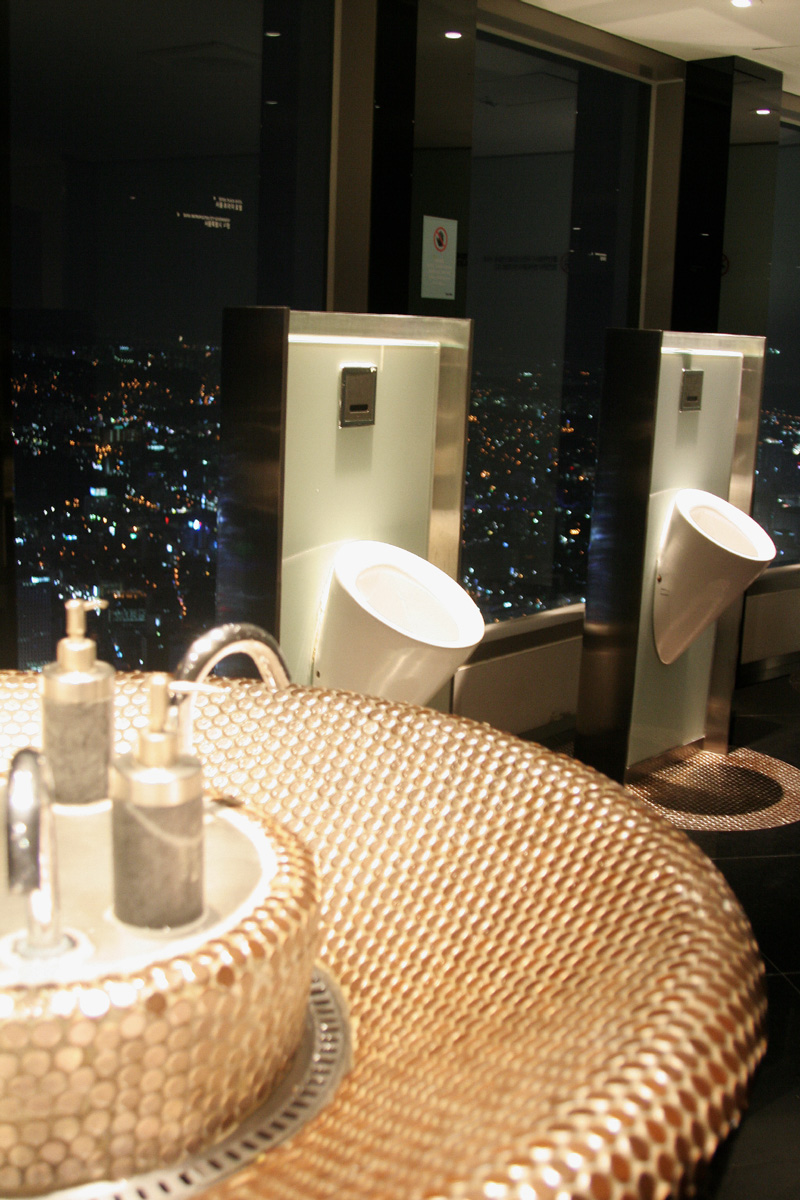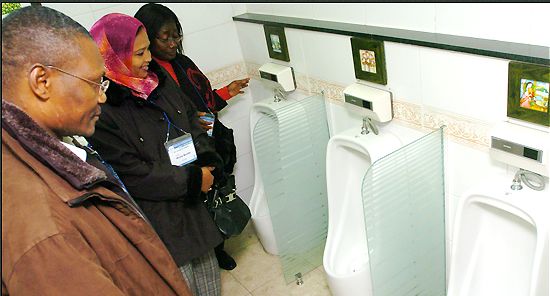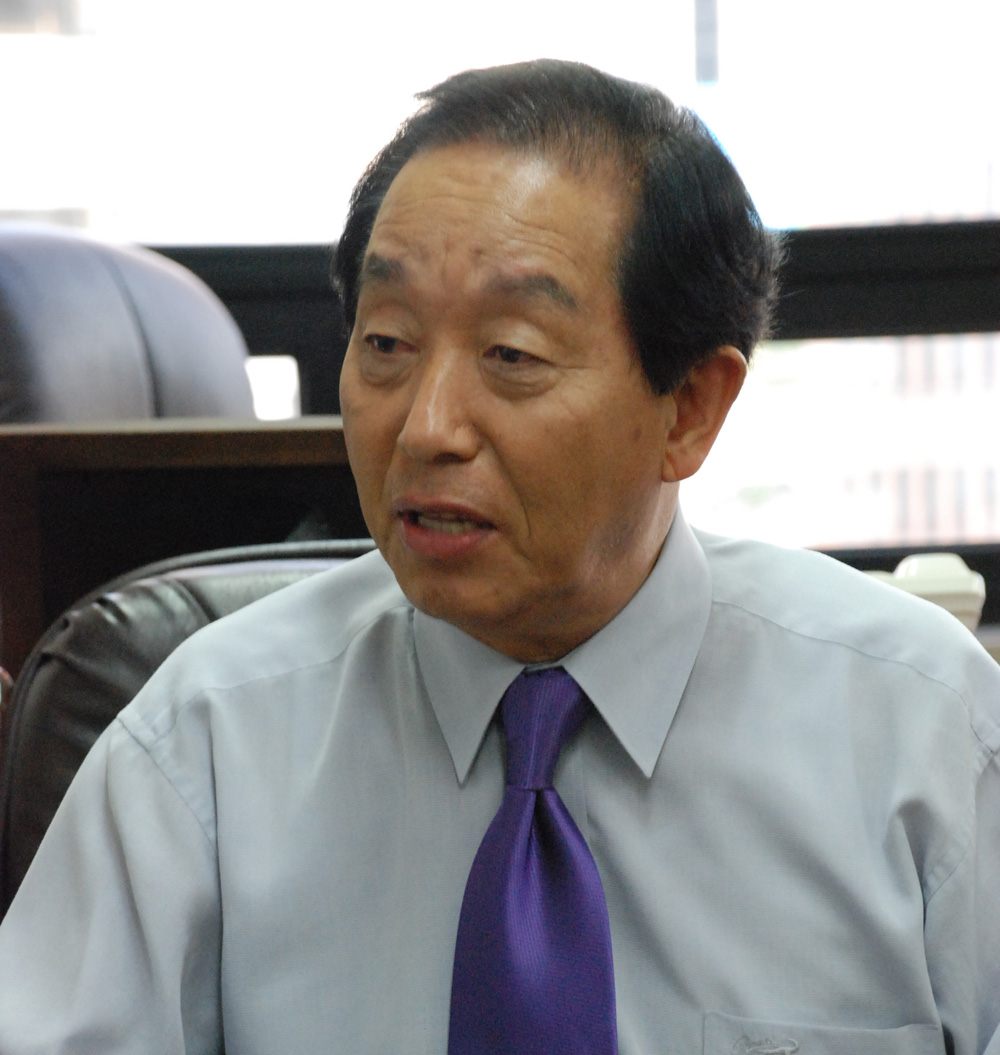Korean toilets leading the world

QUESTION: AS you step inside this place, peaceful classical music first pleases your ears. Paintings are hanging on the wall, shone by the radiant rays of the sun coming through the transparent ceiling. The sweet floral scent tickles your nose and refreshes your mind. It is then you realize that you are in a place so familiar. What is this place?
Many of you may have guessed the answer to the question above, a public restroom, though still wonder why this question seeks the answer seemingly irrelevant to it . Today, toilets in Korea have become surprisingly cleaner and more hygienic in general, transcending the mere conventional concept of satisfying one’s physiological needs.
Compare the gloomy public restrooms back when we were kids with the ones we see now. Such vast changes, called the Korean Restroom Revolution, are attracting global attention. What is more, being the host nation of the WTAA (Inaugural General Assembly of the World Toilet Association), planned to take place this month in Seoul, Korea is about to lead the world in solving matters related to toilets.
Korean restrooms at the center of attention
Recently, Korean restrooms have gained worldwide fame for the successful establishment of the new toilet culture in public restrooms. In preparation for 2002 World Cup, many public restrooms in Korea had been repaired or renovated drastically. During such process, the formerly unhygienic and unpleasant atmosphere of toilets vanished and Korean toilets have constantly been the target of benchmarking from several countries.
China is enthusiastic about renovating its public restrooms for the upcoming Beijing Olympic Games next year. In order to elevate the standards of its public restrooms, which was similar to that of Korea 20 or 30 years ago, China has been striving to follow the path Korea took for the last decade. In November 2006, Korea and China together signed an MOU (Memorandum of Understanding) on exchange and cooperation for the spread of clean toilet facilities. In addition, a Korean toilet company H&G concluded a contract to set up 5,000 water-saving toilets, which amounts to 2.08 million US dollars, at the Beijing Olympic Games.
The efforts to benchmark Korean toilets do not stop here. Brazil has a toilet designed by Korean companies. When the Mayor of Vilhena, a Brazilian city south of Rondonia, visited Korea last year, he took the plan for the “soccer ball shape toilet” with him to Brazil. The toilet is being constructed in the center of Vilhena. Mongolia also has toilets from Korea. “Mongolia lags far behind in toilet standards, which even threatens the sanitary condition of drinking water. Seeing the poor toilet facilities, we decided to donate two restrooms in Ulaanbaatar, Mongolia,” said Kim Jae-Wook (Head, Business Support Team in H&G).
Suwon’s unique toilets contributed greatly to the globalization of Korean toilets. When the KTA (Korea Toilet Association) held a “Suwon toilet tour” for foreign journalists in Seoul last November, over 70 major newspapers across the globe reported the successful advancement of Korean toilets to the world. Such keen interest on Korean toilets triggered changes in the perception of toilets worldwide.

Korea’s efforts to revolutionize toilets
The late 1990’s and early 2000’s have been the revolutionary period for public restrooms in Korea. With the foundation of the KTA and The CCRC (Citizen’s Coalition for Restroom Culture) in 1999, the status of public toilets in Korea began to improve gradually. The ASEM (Asia Europe Meeting) in 2000, Visit Korea Year in 2001, and the World Cup co-hosted by Korea and Japan in 2002 became the stepping stones for Korea’s Toilet Revolution. “Before the toilet culture movement took place in the late 1990’s, one of the factors that foreign visitors felt most uncomfortable about Korea was the toilet. When we examined the conditions of about 4,800 public toilets in Seoul, almost 70% of them turned out to be severely bad,” confessed Pyo Hye-ryoung (President, Citizen’s Coalition for Restroom Culture).
At the alarming status of Korean public restrooms, the government, civic groups, and citizens joined efforts together. “Korea’s toilet movement is especially notable for the cooperation from the three groups of society to change the toilet culture,” Pyo added. The government renovated and repaired the actual facilities and provided the finance, civic groups led the toilet culture movement, and citizens participated in those movements to gradually form the appropriate toilet culture.
On top of all the efforts mentioned above, there is still one more reason why Korea is said to be the leading nation in toilet matters: In 2004, Korea became the first country ever to institute the public restroom law in the world. Before the enactment of this law, the laws regarding toilets had been dispersed through large categories such as hygiene laws and building laws. The public restroom law integrated the scattered laws together. “The law shows the perception of how a country regards the toilet. The separate categorization of restroom laws means that Koreans do not consider toilets as a mere part of a building, but an important place that has a close connection to our life,” stated Jung Mi-kyung (Head, Publicity Team in Organizing Committee for the WTAA).
|
|
Toilets and world sanitation issues
While Koreans worked at full speed for the advancement of public restrooms, there were people who did not even have toilets or any kind of sanitation facilities on the other side of the earth. Toilet and sanitation issues are interrelated subjects. In the places where there is no adequate water supply, people have to drink unpurified water, which might have been polluted by wastes and human feces.
According to the WHO (World Health Organization), around 1.1 billion people do not have access to improved water supply sources globally whereas 2.4 billion people do not have access to any type of improved sanitation facility. Such conditions often cause deaths in the third world. About two million people die every year due to water-borne diseases; most of them are children less than five years of age. “About 40% of the world population lives without toilets. Many of those living in underdeveloped countries in Africa or the Middle East are not even aware of what a toilet is, since they have always lived without one throughout their lives,” told Choi Seung-ho (Chairman, Executive Committee of the WTAA).
In Nepal, for example, only 40% of its citizens are using flush toilets, and the rest are excreting in the forests, fields or river streams. Sewage systems are hard to find, and human feces are polluting water resources such as rivers, streams, and lakes. In such countries, the presence of a toilet is directly related to the existence of the country itself, since poor hygiene might spread water-borne diseases to the entire nation.
Realizing the seriousness of problems related to toilets, the UN (United Nations) will launch the “International Year of Sanitation,” come November, to shift the world focus onto one of the most neglected health issues of our times: the lack of proper sanitation. Moreover, Turkey, Mongolia and Brazil founded a national toilet association with the aid of the KTA and Cambodia and India joined this movement last August.
World Toilet Association
As the country which successfully led the Toilet Revolution, Korea is taking the central role in the global toilet movement. Sponsored by the KTA, Korea is hosting the WTAA, the inaugural ceremony of the WTA, in COEX (Convention & Exhibition), Seoul, from Nov. 21 to 25. At this assembly, about 1,300 representatives from roughly 70 countries are expected to gather together. They will establish the basic framework of the WTA (World Toilet Association) as an international organization by setting up the constitution of the WTA, and discussing the problems related to toilets.
The WTA aims at achieving three major objectives. The primary objective is to reduce water-borne diseases in developing countries. Lack of proper sanitation in underdeveloped countries is, to a great extent, concerned with water-borne diseases such as diarrhea, cholera, and malaria. In order to prevent the widespread of such epidemics caused by the deficiency of toilets, a world organization to handle this matter is in urgent need.
The second is to contribute toward better management of water resources through flush water-saving technologies in both developed and developing countries. It requires eight liters of clean water to flush a toilet once. Some countries are not even able to provide its citizens with that much amount of clean water to drink or wash. Saving water used to flush a toilet will help solve the problems related to an insufficient supply of water. 
The final objective of the WTA is to promote not only clean and functional but also aesthetically pleasing toilet spaces. Toilets should now be regarded as more than just a place for excretion but also a beautiful and comfortable cultural place that is deeply related to our daily life.
At the assembly, the participants will have meetings, take part in a workshop, and inspect Korean public toilets and other cultural assets. Interior Bath & Toilet Expo is also taking place in COEX from Nov. 22 to 24. “I hope a lot of people around the world will show interest in ‘the issue of toilets’ with the foundation of the WTA,” said Sim Jae-duck (Chairman, Organizing Committee for the WTAA).
For a better future of Korean toilets
Compared to 20 or 30 years ago, or even ten years ago, it may be no exaggeration to say that Korean toilets have become a paradise for everyone. The facilities, of course, have gone through a revolution and the hygienic conditions also improved to an incredible degree.
Now it seems clear that the toilet issue, at which many people might have laughed, is stretching its branches to as far as diplomacy, health, and nature preservation. Korea, as well as the world, still has a long way to go. We should put efforts together to enhance the quality of life in every country through providing safe sanitary conditions. It is time that the global society looked at toilets from a different perspective.


 Suwon, home of the Korean toilet movement
Suwon, home of the Korean toilet movement